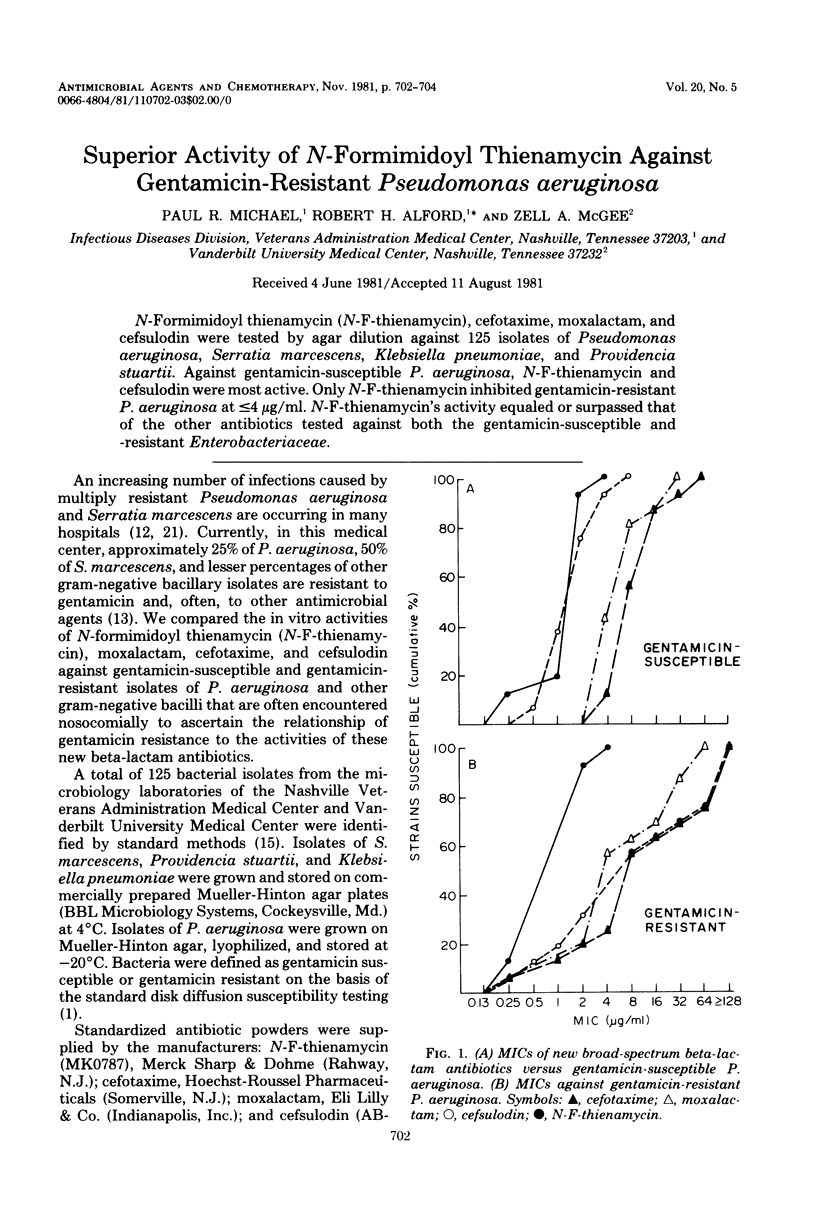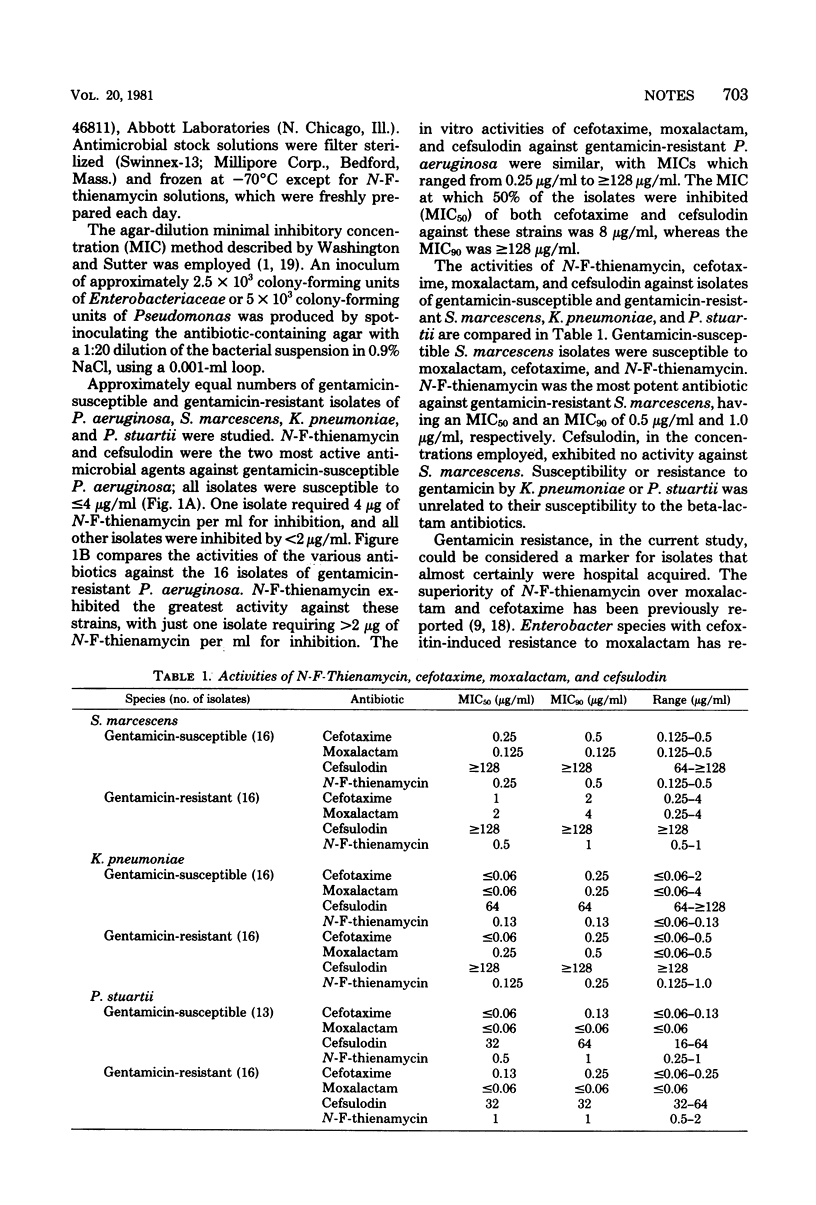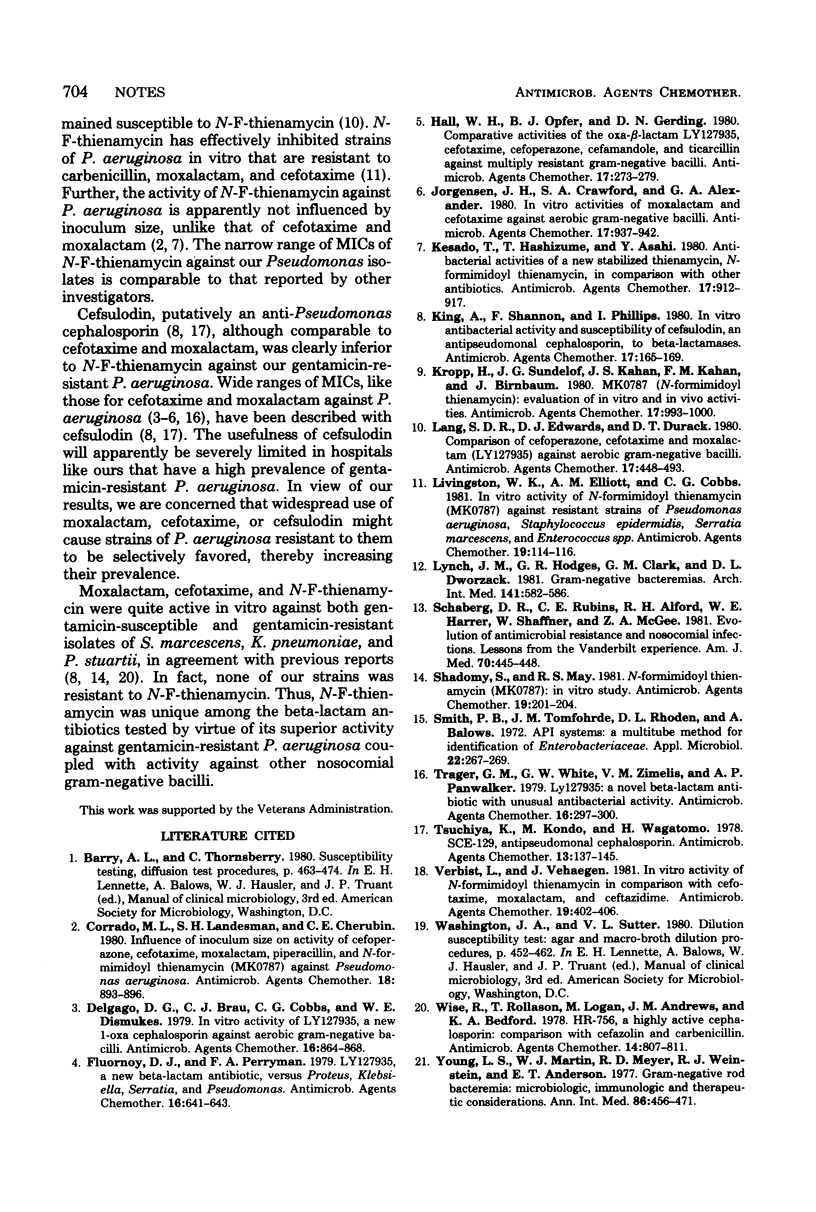Abstract
N-Formimidoyl thienamycin (N-F-thienamycin), cefotaxime, moxalactam, and cefsulodin were tested by agar dilution against 125 isolates of Pseudomonas aeruginosa, Serratia marcescens, Klebsiella pneumoniae, and Providencia stuartii. Against gentamicin-susceptible P. aeruginosa, N-F-thienamycin and cefsulodin were most active. Only N-F-thienamycin inhibited gentamicin-resistant P. aeruginosa at less than or equal to 4 microgram/ml. N-F-thienamycin's activity equaled or surpassed that of the other antibiotics tested against both the gentamicin-susceptible and -resistant Enterobacteriaceae.
Full text
PDF


Selected References
These references are in PubMed. This may not be the complete list of references from this article.
- Corrado M. L., Landesman S. H., Cherubin C. E. Influence of inoculum size on activity of cefoperazone, cefotaxime, moxalactam, piperacillin, and N-formimidoyl thienamycin (MK0787) against Pseudomonas aeruginosa. Antimicrob Agents Chemother. 1980 Dec;18(6):893–896. doi: 10.1128/aac.18.6.893. [DOI] [PMC free article] [PubMed] [Google Scholar]
- Delgado D. G., Brau C. J., Cobbs C. G., Dismukes W. E. In vitro activity of LY127935, a new 1-oxa cephalosporin, against aerobic gram-negative bacilli. Antimicrob Agents Chemother. 1979 Dec;16(6):864–868. doi: 10.1128/aac.16.6.864. [DOI] [PMC free article] [PubMed] [Google Scholar]
- Flournoy D. J., Perryman F. A. LY127935, a new beta-lactam antibiotic, versus Proteus, Klebsiella, Serratia, and Pseudomonas. Antimicrob Agents Chemother. 1979 Nov;16(5):641–643. doi: 10.1128/aac.16.5.641. [DOI] [PMC free article] [PubMed] [Google Scholar]
- Hall W. H., Opfer B. J., Gerding D. N. Comparative activities of the oxa-beta-lactam LY127935, cefotaxime, cefoperazone, cefamandole, and ticarcillin against multiply resistant gram-negative bacilli. Antimicrob Agents Chemother. 1980 Feb;17(2):273–279. doi: 10.1128/aac.17.2.273. [DOI] [PMC free article] [PubMed] [Google Scholar]
- Jorgensen J. H., Crawford S. A., Alexander G. A. In vitro activities of moxalactam and cefotaxime against aerobic gram-negative bacilli. Antimicrob Agents Chemother. 1980 Jun;17(6):937–942. doi: 10.1128/aac.17.6.937. [DOI] [PMC free article] [PubMed] [Google Scholar]
- Kesado T., Hashizume T., Asahi Y. Antibacterial activities of a new stabilized thienamycin, N-formimidoyl thienamycin, in comparison with other antibiotics. Antimicrob Agents Chemother. 1980 Jun;17(6):912–917. doi: 10.1128/aac.17.6.912. [DOI] [PMC free article] [PubMed] [Google Scholar]
- King A., Shannon K., Phillips I. In vitro antibacterial activity and susceptibility of cefsulodin, an antipseudomonal cephalosporin, to beta-lactamases. Antimicrob Agents Chemother. 1980 Feb;17(2):165–169. doi: 10.1128/aac.17.2.165. [DOI] [PMC free article] [PubMed] [Google Scholar]
- Kropp H., Sundelof J. G., Kahan J. S., Kahan F. M., Birnbaum J. MK0787 (N-formimidoyl thienamycin): evaluation of in vitro and in vivo activities. Antimicrob Agents Chemother. 1980 Jun;17(6):993–1000. doi: 10.1128/aac.17.6.993. [DOI] [PMC free article] [PubMed] [Google Scholar]
- Lang S. D., Edwards D. J., Durack D. T. Comparison of cefoperazone, cefotaxime, and moxalactam (LY127935) against aerobic gram-negative bacilli. Antimicrob Agents Chemother. 1980 Mar;17(3):488–493. doi: 10.1128/aac.17.3.488. [DOI] [PMC free article] [PubMed] [Google Scholar]
- Livingston W. K., Elliott A. M., Cobbs C. G. In vitro activity of N-formimidoyl thienamycin (MK0787) against resistant strains of Pseudomonas aeruginosa, Staphylococcus epidermidis, Serratia marcescens, and Enterococcus spp. Antimicrob Agents Chemother. 1981 Jan;19(1):114–116. doi: 10.1128/aac.19.1.114. [DOI] [PMC free article] [PubMed] [Google Scholar]
- Lynch J. M., Hodges G. R., Clark G. M., Dworzack D. L. Gram-negative bacteremias. Analysis of factors for clinical assessment of gentamicin resistance. Arch Intern Med. 1981 Apr;141(5):582–586. doi: 10.1001/archinte.141.5.582. [DOI] [PubMed] [Google Scholar]
- Schaberg D. R., Rubens C. E., Alford R. H., Farrar W. E., Schaffner W., McGee Z. A. Evolution of antimicrobial resistance and nosocomial infection. Lessons from the Vanderbilt experience. Am J Med. 1981 Feb;70(2):445–448. doi: 10.1016/0002-9343(81)90786-5. [DOI] [PubMed] [Google Scholar]
- Shadomy S., May R. S. N-formimidoyl thienamycin (MK0787): in vitro study. Antimicrob Agents Chemother. 1981 Jan;19(1):201–204. doi: 10.1128/aac.19.1.201. [DOI] [PMC free article] [PubMed] [Google Scholar]
- Trager G. M., White G. W., Zimelis V. M., Panwalker A. P. LY-127935: a novel beta-lactam antibiotic with unusual antibacterial activity. Antimicrob Agents Chemother. 1979 Sep;16(3):297–300. doi: 10.1128/aac.16.3.297. [DOI] [PMC free article] [PubMed] [Google Scholar]
- Tsuchiya K., Kondo M., Nagatomo H. SCE-129, antipseudomonal cephalosporin: in vitro and in vivo antibacterial activities. Antimicrob Agents Chemother. 1978 Feb;13(2):137–145. doi: 10.1128/aac.13.2.137. [DOI] [PMC free article] [PubMed] [Google Scholar]
- Verbist L., Verhaegen J. In vitro activity of N-formimidoyl thienamycin in comparison with cefotaxime, moxalactam, and ceftazidime. Antimicrob Agents Chemother. 1981 Mar;19(3):402–406. doi: 10.1128/aac.19.3.402. [DOI] [PMC free article] [PubMed] [Google Scholar]
- Wise R., Rollason T., Logan M., Andrews J. M., Bedford K. A. HR 756, a highly active cephalosporin: comparison with cefazolin and carbenicillin. Antimicrob Agents Chemother. 1978 Dec;14(6):807–811. doi: 10.1128/aac.14.6.807. [DOI] [PMC free article] [PubMed] [Google Scholar]
- Young L. S., Martin W. J., Meyer R. D., Weinstein R. J., Anderson E. T. Gram-negative rod bacteremia: microbiologic, immunologic, and therapeutic considerations. Ann Intern Med. 1977 Apr;86(4):456–471. doi: 10.7326/0003-4819-86-4-456. [DOI] [PubMed] [Google Scholar]


